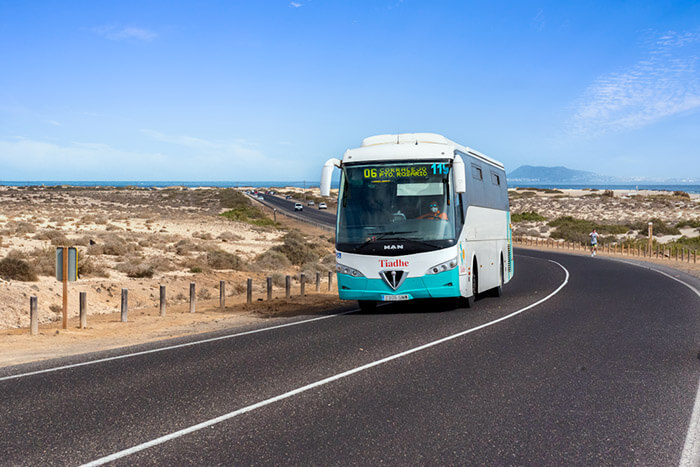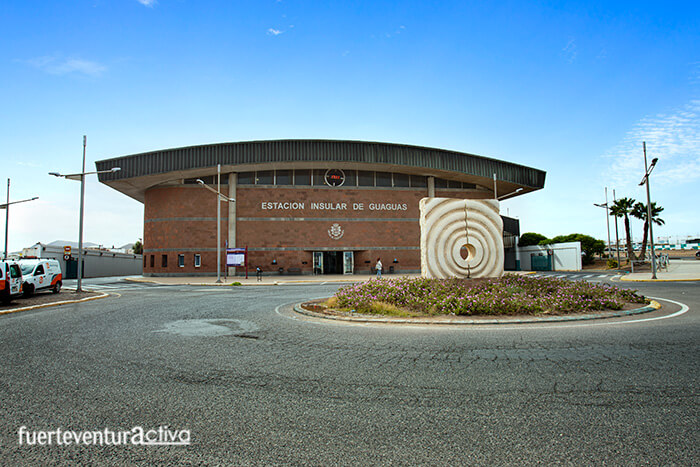LIFE IN FUERTEVENTURA, What to see in Fuerteventura ?
Fuerteventura by bus
Fuerteventura is a very popular island. The more than 2 million tourists who arrive annually on the island corroborate this. If you are an active traveler and you like to get to know the unique landscapes of the island, the best option is to rent a car.
However, you may be wondering if it would be possible to visit Fuerteventura by bus.
Guagua is what we call buses in the Canary Islands.
Today we answer that question. We will give you the keys so that you can enjoy the island by bus. But first, a couple of historical paragraphs about passenger transport in Fuerteventura.
Evolution of public transport in Fuerteventura
No one is unaware that motor vehicles, and more specifically buses, are a relatively recent invention if we compare it with the centuries of human occupation of the island.
The European conquest of Fuerteventura brought with it the need to move people and goods quickly and efficiently.
From the 15th century to the first decades of the 20th, mobility on the island changed little.

Fuerteventura was interconnected by a wide network of seaports that was complemented by animal-drawn transport: camels and donkeys, essentially.
So if you wanted to travel from one end of the island to the other, let’s say that from Corralejo to the south of Fuerteventura, you had to take a boat in the port of Corralejo and after several hours along the coast you would have to get off in Gran Tarajal, Tarajalejo , or Morro Jable. Later it was necessary to look for a camel driver that would bring you closer to your destination. That was the most agile way of insular communication, saving many hours of travel through tortuous and uncomfortable roads.
The transport of people and merchandise by camel was in force until the middle of the 20th century.
Travelers like Olivia Stone, George Glas, or naturalists like Sabin Berthelot and Barker Webb toured Fuerteventura on camelback

The beginning of tourism brought with it the need to create new internal communication channels that had to interconnect the tourist centers with the towns where the hotel workers lived.
Until the middle of the 20th century there was no public bus service in Fuerteventura.
Where does the word guagua come from?

To find the etymological origin of the word guagua, we consulted both the Canarian Academy of Language and the book “Speaking well does not cost so much” by Pancracio Celdrán. He tells us.
“Guagua. As for the origin of this term of use in the Canary archipelago, some believe that it is a voice imported from Cuba, where it was born from the corruption of the English word waggon. However, it is convenient to keep in mind the adverbial idiom “de guagua” = free, for free. For the consolidation of the term, perhaps there was a cross between both words, a cross consisting of joining the name of the vehicle, an animal draft wagon, and the cheapness of that type of transport for Cuban sugar cane cutters who returned home from work in those dilapidated vans for symbolic payment: they rode as a bus, almost for free. Others consider that it is an onomatopoeic term imitative of the sound of the horn of those vehicles, very particular and striking.”
To this we want to add that the first American company that exported buses to the island of Cuba was WaWa & Co. Inc. (Washington, Walton, and Company Incorporated), and that when the bus approached the stop the driver honked his horn repeatedly. So when they heard it, people said: “Here comes the bus!”

The strong ties that unite the Canary Islands and Cuba made Americanism spread in the islands. In fact, before adopting the word guagua, we called buses in the Canary Islands “omnibus”, “hour cars” and even “planters”.
Getting around Fuerteventura in a Guagua

The bus is the cheapest way to visit Fuerteventura. The TIADHE company (Transportes Insulares Antonio Díaz Hernández) has been the concessionaire for regular passenger transport in Fuerteventura for decades.
The island has 18 regular lines that connect the main Majorera towns. Logically they are not enough for the residents of Fuerteventura to depend on public transport, but enough for the occasional traveler to get to know the island, without many complications. Moreover, traveling by bus is the best option if you only want to visit the main tourist centers of Fuerteventura: Corralejo, El Cotillo, Caleta de Fuste, Costa Calma, Morro Jable, Betancuria, Vega del Río Palmas, Puerto del Rosario, etc. Without a doubt, the buses most used by tourists are those that bring them closer to the beaches.
Here you have the link to the TIADHE routes and schedules.
Another aspect that we like the most when moving around Fuerteventura by bus is being able to go to Cofete without having to take a private vehicle. There is a line that takes you from Morro Jable to the fantastic Cofete beach.

It is also possible to go by bus to major cultural events, music festivals or massive patron saint festivities. During the days that the event in question lasts, the TIADHE company, in coordination with the institutions, not only increases the hours and frequency of the regular lines, but also creates new “shuttle” routes, to make it easier and more comfortable to access the event. without having to take the car.
Fuerteventura has two bus stations. One in Morro Jable and the other in Puerto del Rosario. These buildings, in addition to being places of great movement of suitcases and travelers, often become enclaves where cultural activities fill the space.

Also, if you choose to travel by public transport during your vacation, you can purchase a transport voucher (BtF) at the bus stations. With it you will save 10% on the cost of each trip.
Fuerteventura2 Fuerteventura1 Fuerteventura5 Fuerteventura6





